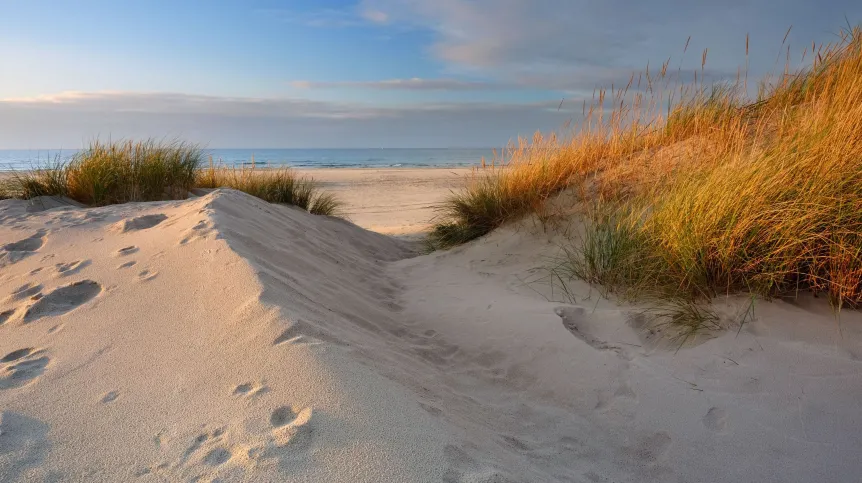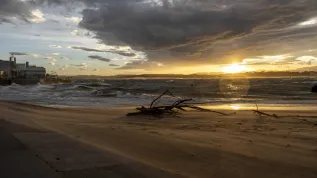
The condition of coastal dune habitats has been poor for years due to a significant number of trees, the presence of trodden paths and rubbish, says Dr. Magdalena Lazars from the University of Gdańsk and manager of the dune saving project 'LIFE for Dunes PL’.
The aim of the project is to protect and renaturalise coastal dune habitats, and conduct scientific research that constitutes the foundation for the effective management of the Baltic coastal zone. The project covers parts of the Baltic Sea coast in Poland, Germany and Lithuania, which are protected as part of the Natura 2000 network.
The project has been co-financed by the European Union to the amount of over EUR 8.6 million, of which over EUR 3.6 million will go to the University of Gdańsk. The university’s part of the project is led by Dr. Lazarus from the Department of Plant Taxonomy and Nature Conservation at the Faculty of Biology.
PAP: The 'LIFE for Dunes PL' project, which you manage, received funding of EUR 3.6 million. What actions will you - scientists - take?
Magdalena Lazarus: The project includes a number of activities planned in response to the existing threats. We would like to develop a method for analysing the state of preservation of dune habitats based on aerial photos obtained from a drone (or satellite). Such methods are becoming more popular because they enable efficient analysis of large areas with the involvement of a small number of people.
Assessment of the state of preservation of habitats will be particularly useful, for example, after the occurrence of violent weather phenomena, but it will also be possible to estimate the spread of invasive species, etc. We have also planned research activities, including research on the stability of dune ridges, as well as ongoing geomorphological phenomena. Finding answers to a number of questions we have will enable more efficient planning of solutions to preserve these valuable habitats.
PAP: What is the main part of the project?
M.L.: Restoration of dune habitats by removing invasive plant species, as well as rejuvenation of habitats by removing trees. In the case of improper use of dune ridges by tourists, we have planned an extensive educational campaign. We hope that we will be able to convince beach and sea lovers that together we can protect these valuable habitats.
PAP: Which coastal dunes are at risk of disappearing?
M.L.: The deterioration of non-forest dune habitats is unfortunately a problem that affects the entire sea coast, not only its part in Poland. It affects the Baltic coast and more - these habitats are also threatened in many Western European countries.
PAP: What factors influence the disappearance of coastal dunes?
M.L.: There are several such factors. One of them is the introduction in the past (and partly also currently) of plant species imported from other geographical zones and planting them on the dunes in order to stabilize the sand. Unfortunately, the effect after many years is that instead of natural dune vegetation, in many places we have willow thickets or aggregations of beach rose.
Another problem is that tourists ignore the prohibition of entering the dunes. Dune habitats are sensitive to trampling, and if we add the rubbish people leave behind, this unfortunately does not contribute to the protection of dune nature.
Many areas of the coastal dunes were also forested in the past (mainly Scots pine was planted, but not exclusively). Mixed and coniferous forests on dunes are naturally formed plant clusters that are also valuable in themselves, but if we introduce plantings, we disturb the balance between forest and non-forest habitats, which in many places leads to the disappearance of the latter or their reduction to a narrow dune embankment belt. If we add climate change (e.g. violent storms blowing away and washing away the dune sand), in many places we have a situation in which the sea meets a narrow beach, there are no ridges of non-forest dunes, and instead sea water washes away the forest. This list of factors does not exhaust all threats to coastal dune habitats.
PAP: How would you rate the state of preservation of Polish dunes?
M.L.: The state of preservation of natural habitats is a feature that is regularly assessed and reported to the European Commission. The final assessment is three-degree: the condition may be good, unsatisfactory or poor. In the case of coastal dune habitats, this condition has been unfortunately poor for years, which is influenced by the factors mentioned above (the presence of invasive species, a significant share of trees, the presence of trodden paths, rubbish, etc.).
PAP: Are we at risk of complete disappearance of dunes?
M.L.: The complete disappearance of non-forest coastal dunes is unlikely. We effectively protect the coast in Poland, for example in the area of the Słowiński National Park, but not only there. Without active protection measures, the area of well-preserved non-forest dunes will certainly be decreasing at a faster rate. The result will be a decrease in biodiversity and natural diversity of habitats.
Interview by Piotr Mirowicz (PAP)
PAP - Science in Poland
pm/ agt/ lm/ kap/
tr. RL













